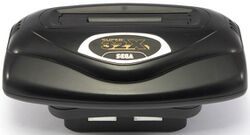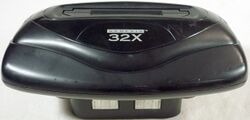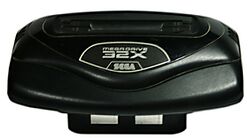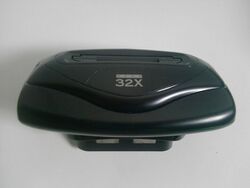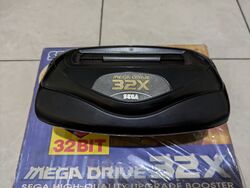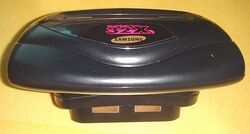Difference between revisions of "Sega 32X"
From Sega Retro
| Line 358: | Line 358: | ||
32X PAL logo.png|European/Australian logo | 32X PAL logo.png|European/Australian logo | ||
32x BR Logo.png|Brazilian logo | 32x BR Logo.png|Brazilian logo | ||
| + | </gallery> | ||
| + | |||
| + | ==Patents== | ||
| + | <gallery> | ||
| + | Patent USD369352.pdf|USD369352 | ||
</gallery> | </gallery> | ||
Revision as of 09:35, 14 May 2017
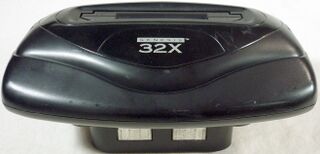
| ||||||||||||||||||||||||||||||||||||||||||||||||||
| Sega 32X | ||||||||||||||||||||||||||||||||||||||||||||||||||
|---|---|---|---|---|---|---|---|---|---|---|---|---|---|---|---|---|---|---|---|---|---|---|---|---|---|---|---|---|---|---|---|---|---|---|---|---|---|---|---|---|---|---|---|---|---|---|---|---|---|---|
| Manufacturer: Sega | ||||||||||||||||||||||||||||||||||||||||||||||||||
|
The Sega 32X (スーパー32X) codenamed Project Mars, is a hardware add-on to the Sega Mega Drive created by Sega. It is the second of two major add-ons for the system, the other being the Sega Mega-CD, and was released worldwide in late 1994. The 32X was designed to extend the Mega Drive's lifespan by giving it significantly more powerful 32-bit processing and texture-mapped 3D polygon capabilities. It was thus seen as a logical upgrade to the 16-bit processing and 2D capabilities of the Mega Drive and its main rival, the Super Nintendo Entertainment System. The 32X was succeeded by the Sega Saturn.
In the interests of simplicity, Sega Retro uses a simplified "Sega 32X" name for the unit, though the official name differs depending on regions of the world. In Japan, it was distributed under the name Sega Super 32X, in North America, the Sega Genesis 32X, in Europe, Australia and Asia, the Sega Mega Drive 32X, in Brazil, the Mega 32X and in South Korea, the Super 32X.
Contents
Hardware
The Sega 32X is a large and heavy "mushroom-shaped" unit which plugs into the Mega Drive's cartridge slot. The 32X also plays its own cartridges which are designed to take advantage of the enhancements of the system - cartridges which will not physically fit in a standard Mega Drive. The 32X cannot function as an independent machine, but unlike the Power Base Converter it was designed to be a permanent addition to the Mega Drive setup, doubling up as a passthrough device allowing normal Mega Drive games to still be played. The 32X came with ten coupons and a plastic spacer, ensuring it can work with most versions of the Mega Drive console.
As an aside, the 32X's video encoder is of a slightly higher build quality than those usually found in later iterations of the Mega Drive, potentially resulting in a slightly clearer image when playing Mega Drive titles.
Numerous factors led to the criticism over the 32X, but one of the major issues is encountered before the system is even switched on. The device requires its own AC adaptor, and a second physical connection to the Mega Drive console from the back of the unit. If the user also has a Mega-CD, this means no less than three power adapters are required (plus a fourth for a television). Both the AC adaptor and 32X Connector Cable are bespoke units - the AC adaptor is more common as it is identical to that seen with the Mega Drive 2 (though is not often covered by universal AC adaptors), but the 32X connector cable is unique to the 32X and was not sold separately (though third parties variants exist).
Furthermore, Sega's AC adaptors of the day were designed so that the transformer was located around the plug area, resulting in several bulky units obstructing surrounding sockets. Due to the extra space required just to plug the console into the wall, Sega eventually released their own Sega Power Strip in North America.
The 32X brings significant visual upgrades to the Mega Drive, including being able to display more colors on-screen (32,768 at once, which was an important requirement for games featuring 3D graphics and full-motion video and had hence been a common complaint with the Mega-CD), scaling and rotation, and significantly enhanced 3D graphics capabilities provided by its two Hitachi SH-2 32-bit RISC processors (also used for the Saturn) and 32X VDP.
Audio capabilities were also upgraded, including the addition of QSound technology, which enables multidimensional sound that allows a regular stereo audio signal to approximate the 3D sounds heard in everyday life (similar to binaural recording).
The 32X is compatible with the Sega Mega-CD, allowing the user to play one of six enhanced Sega Mega-CD 32X games.
North American marketing pitched the 32X as being 40 times more powerful than the Super NES and 6 times more powerful than the 3DO. This is true in terms of CPU performance, as the 32X's dual SH-2 are capable of processing nearly 60 MIPS, compared to the Super NES's Ricoh 5A22 which processes 1.5 MIPS and the 3DO's ARM60 which processes 10 MIPS. In terms of 3D polygon performance, the 32X is capable of rendering 160,000 flat-shaded polygons/sec and 50,000 textured polygons/sec. In comparison, the 3DO renders 20,000 textured polygons/sec,[7] while the Super Nintendo's Super FX 2 cartridge enhancement chip renders 4000 flat-shaded polygons/sec and 2000 textured polygons/sec, thus the 32X renders 40 times as many polygons as the Super FX 2 chip and more than twice as many textured polygons as the 3DO. Compared to other systems at the time, the Atari Jaguar renders 10,000 textured polygons/sec,[8] while a Pentium 60 PC renders 30,000–50,000 flat-shaded polygons/sec[9] and 6000 textured polygons/sec,[10] and the Pentium 66 renders 3.6 MPixels/s[11] (compared to the 32X's 18–36 MPixels/s). The 32X was generally the most powerful home system released to the Western world in 1994, since the more powerful Saturn and PlayStation were only released in Japan at the time.
Models
- Main article: 32X consoles.
Contrary to popular belief, the Sega 32X doesn't employ any regional lockout technology per se, instead relying on the region of the Mega Drive to determine the region of the unit. It does however have a set Genlock frequency which stops 50Hz (PAL) games from working on 60Hz (NTSC) units and vice versa. Due to the 32X only differentiating between frequencies and not region, the Japanese Super 32X and Genesis 32X are identical, and will work on either NTSC console. Much like region modifications on the Mega Drive and Saturn, this is easily changed with slight modifications to the unit, allowing for universal support of all games.
Cartridges
- Main article: Sega 32X cartridges.
Technical specifications
- See Sega Mega Drive specifications for base Mega Drive hardware specifications
CPU
- Main CPU: Twin Hitachi SH-2 (SH7095) 32-bit RISC processors
- Clock speed: 23.01136 MHz (NTSC), 22.801467 MHz (PAL)[12]
- Clock cycles: 46.022721 MHz (NTSC, 23.01136 MHz per SH-2), 45.602934 MHz (PAL, 22.801467 MHz per SH-2)
- 2x CPU cores: 32‑bit RISC instructions/registers, up to 4 instructions/cycle (2 instructions/cycle per SH-2),[13] 1.3 MIPS per MHz,[14] 59.829537 MIPS (NTSC, 29.914768 MIPS per SH-2), 59.283814 MIPS (PAL, 29.641907 MIPS per SH-2)
- 4x internal fixed‑point math processors:[15] 2x MULT multiplier DSP,[16][17][18] 2x DIVU division units,[16][17] parallel processing[19]
- 2x DMA units: 2x DMAC (Direct Memory Access Controller),[16] parallel processing[22]
- Bus width: 64‑bit (2× 32‑bit) internal, 32‑bit external[23]
- CPU co-processors: Overlay/Underlay processors
- Mega Drive CPU:
- Motorola M68000 — 7.670453 MHz (NTSC), 7.600489 MHz (PAL),[12] 16/32-bit instructions, 32-bit internal data bus, 16-bit external data bus, 1.342329 MIPS (NTSC), 1.330085 MIPS (PAL)
- Zilog Z80 — 3.579545 MHz (NTSC), 3.546894 MHz (PAL), 8/16-bit instructions, 8-bit data bus, 0.519034 MIPS (NTSC), 0.514299 MIPS (PAL)
- Sega CD CPU: Motorola M68000 — 12.5 MHz, 2.1875 MIPS
- Mega Drive CPU:
Graphics
- 32X graphics chip: Sega 32X VDP (Sega Custom LSI) @ 23.01136 MHz (NTSC), 22.801467 MHz (PAL)[24][12]
- Data bus width: 32-bit (16-bit per framebuffer)
- Word length: 16-bit
- Features: 3D polygon graphics, Gouraud shading, texture mapping, more sprites, quicker animation[25]
- Color palette: 32,768 colors[26]
- Double-buffered framebuffer with three modes:[27]
- 8bpp "packed pixel" mode: 256 simultaneous colors on screen; each pixel is an index into CRAM (can use full screen)
- 16bpp "run length" mode: 256 simultaneous colors on screen; each pixel is both a number of pixels to display and the index of CRAM (limits screen size)
- 16bpp "direct color" mode: 32,768 simultaneous colors on screen; each pixel is the color value (limits screen size)
- VRAM: 256 KB, split into two 128 KB segments for each framebuffer. A priority system allows partial overlaying/underlaying of Mega Drive/Mega-CD graphics.
- Sprites, polygons and textures accessed from 256 KB main SDRAM and 4–8 MB ROM cartridge.
- Resolutions: 320×224, 320×240,[27] 320×204 (direct color),[28] 320×408 (8bpp)[29]
- Overscan: 450×262 (NTSC), 450×313 (PAL)[30]
- Refresh rate: 60 Hz (NTSC), 50 Hz (PAL)
- Maximum frame rate: 60 FPS (NTSC), 50 FPS (PAL)
- Framebuffer bandwidth: 72.727272 MB/s (36.363636 MB/s per framebuffer)[31][32]
- Framebuffer fillrate: 18.181818 MPixels/s (16bpp), 36.363636 MPixels/s (8bpp)[29][37]
- 3D polygon geometry calculations:[fn 3]
- Polygon transformations: 260,000 polygons/sec[fn 4]
- Lighting calculations: 230,000 polygons/sec (flat),[fn 5] 180,000 polygons/sec (Gouraud)[fn 6]
- 3D polygon rendering:
- Flat shading: 160,000 polygons/sec[fn 7]
- Gouraud shading: 100,000 polygons/sec[fn 8]
- Texture mapping: 50,000 polygons/sec[43][fn 9]
- Texture Gouraud shading: 40,000 polygons/sec[fn 10]
- 2D sprite/tile capabilities: Scrolling,[45] scaling, rotation, alpha blending[46][32]
- Colors per sprite/tile: 128 (8bpp), 256 (8bpp), 8192 (16bpp), 32,768 (16bpp)
- Tile size: 8×8 texels, 64 bytes (8bpp), 128 bytes (16bpp)
- Sprite sizes: 8×8 to 320×240 texels, 64 bytes to 150 KB
- Maximum sprites/tiles per frame: 3800 sprites/tiles (8bpp, 8×8, 237.5 KB), 1900 sprites/tiles (16bpp, 8×8, 237.5 KB)
- Maximum sprites/tiles per scanline: 1463 texels, 182 sprites/tiles (8×8)
Overlay/Underlay
- Overlay/Underlay graphics processors:
- Overlay/Underlay Mega Drive VDP planes: 512–1536 color palette, 61–512 colors on screen
- Sprite plane: 80 sprites/frame, 8×8 to 32×32 pixels/sprite, 16 colors/sprite, maximum 1280 sprite tiles/frame
- Background planes: 2 tiled scrolling background layers, 8×8 pixels/tile, 16 colors/tile, 320×224 tilemaps, maximum 1808 tiles/frame
- Fillrate: 6.934358 MPixels/s (read), 6.41376 MPixels/s (write), 6.934358–36.325644 MPixels/s (effective tile fillrate)
- Overlay/Underlay Sega CD ASIC planes: Enhanced Mega Drive VDP planes, enhanced FMV plane
- Sprite/Tile planes: 128–1536 colors on screen, sprite/tile scaling and rotation
- FMV plane: Full motion video, 32,768 colors on screen
- Fillrate: 6.934358 MPixels/s (read/write), 6.934358–36.325644 MPixels/s (effective tile fillrate)
Sound
- Sound chip: QSound PWM @ 23.01136 MHz (NTSC), 22.801467 MHz (PAL)[47]
- Stereo PWM (Pulse Wave Modulation) mixing with Mega Drive sound; additional 2 channels (12 channels in total)
- 11-bit PWM, stereo PCM output,[26] surround sound
Memory
Bandwidth
- System RAM bandwidth: 118.749992 MB/s (NTSC), 118.330206 MB/s (PAL), 3 data buses, 48-bit data bus width[24][32]
- Cartridge bandwidth:[50][32]
- Game ROM: 13.333333 MB/s (16-bit, 6.666666 MHz, 150 ns) to 28.571428 MB/s (16-bit, 14.285714 MHz, 70 ns)
- Non-volatile SRAM: 6.666666 MB/s (6.666666 MHz, 150 ns) to 14.285714 MB/s (14.285714 MHz, 70 ns)
- Internal processor cache bandwidth:
- SH-2: 184.09088 MB/s (92.04544 MB/s per SH-2, 32-bit per SH-2)
- 32X VDP: 92.04544 MB/s (32-bit, 23.01136 MHz), including 46.02272 MB/s (16-bit, 23.01136 MHz) color palette RAM[54]
Storage
- Cartridge: Compatible with all Mega Drive models, JVC Wondermega can store save game/score information.
- CD-ROM: If you have a Sega Mega-CD; speed same as Sega Mega-CD compatible with audio CD, CD&G, SegaCD and JVC WonderMega
Input/Output
- I/O: Same as Mega Drive; 32X upgradable; can upgrade the 32X
History
- Main article: History of the Sega 32X.
Games
List of games
- Main article: List of 32X games.
Games marked with asterisks(*) are enhanced versions of previous Sega Mega-CD-only games, taking advantage of the 32X's improved graphics, which require both the 32X and Mega-CD in order to be played (see Sega Mega-CD 32X).
- After Burner Complete (1995)
- BC Racers (1995)
- Blackthorne (1995)
- Brutal Unleashed: Above the Claw (1995)
- Corpse Killer (1994)*
- Cosmic Carnage (1995)
- Darxide (1995)
- Doom (1994)
- Fahrenheit (1995)*
- FIFA Soccer '96 (1995)
- Golf Magazine: 36 Great Holes Starring Fred Couples (1995)
- Knuckles' Chaotix (1995)
- Kolibri (1995)
- Metal Head (1995)
- Mortal Kombat II (1995)
- Motocross Championship (1995)
- NBA Jam Tournament Edition (1995)
- NFL Quarterback Club (1995)
- Night Trap (1994)*
- Pitfall: The Mayan Adventure (1995)
- Primal Rage (1995)
- RBI Baseball '95 (1995)
- Sangokushi IV (1995)
- Slam City with Scottie Pippen (1995)*
- Space Harrier (1994)
- Spider-Man: Web of Fire (1996)
- Star Trek: Starfleet Academy Starship Bridge Simulator (1995)
- Star Wars Arcade (1994)
- Stellar Assault (1995)
- Supreme Warrior (1995)*
- Surgical Strike (199x)*
- T-Mek (1995)
- Tempo (1995)
- Toughman Contest (1995)
- Virtua Fighter (1995)
- Virtua Racing Deluxe (1994)
- World Series Baseball Starring Deion Sanders (1995)
- WWF RAW (1995)
- WWF WrestleMania: The Arcade Game (1995)
- Zaxxon's Motherbase 2000 (1995)
Launch titles
Japan
North America
Europe
Magazine articles
- Main article: Sega 32X/Magazine articles.
Promotional material
Print advertisements
- 32X ES PrintAd 1994-11 1.jpg
ES print advert 1
- 32X ES PrintAd 1994-11 2.jpg
ES print advert 2
also published in:
- Sega Visions (US) #22: "December/January 1994/1995" (1994-xx-xx)[57]
also published in:
- Game Players (US) #0802: "Vol. 8 No. 2 February 1995" (1995-0x-xx)[58]
- Sega Visions (US) #23: "February/March 1995" (199x-xx-xx)[59]
also published in:
- VideoGames (US) #77: "June 1995" (1995-0x-xx)[60]
- Game Players (US) #0807: "Vol. 8 No. 7 July 1995" (1995-0x-xx)[61]
also published in:
- Mean Machines Sega (UK) #40: "February 1996" (1995-12-xx)[62]
- Sega Pro (UK) #57: "May 1996" (1996-03-21)[63]
also published in:
- CD Consoles (FR) #3: "Janvier 1995" (199x-xx-xx)[64]
Television advertisements
US TV advert
US TV advert
US TV advert (with Chill E.B.)
US TV advert (with Chill E.B.) (2)
Artwork
Patents
External links
Footnotes
- ↑ [1 operation per cycle[20] 1 operation per cycle[20]]
- ↑ [39 cycles per divide[21] 39 cycles per divide[21]]
- ↑ [46,022,720 DSP operations/sec, 1,180,069 DIVU divides/sec 46,022,720 DSP operations/sec, 1,180,069 DIVU divides/sec]
- ↑ [96 adds/multiplies and 9 divides per polygon:[38]
- 131,118 polygons/sec: 12,587,328 DSP operations, 1,180,069 DIVU divides
- 134,397 polygons/sec: 32,255,280 SH-2 cycles (96 adds/multiplies, 144 divide cycles)[21]
- 131,118 polygons/sec: 12,587,328 DSP operations, 1,180,069 DIVU divides
- 134,397 polygons/sec: 32,255,280 SH-2 cycles (96 adds/multiplies, 144 divide cycles)[21]]
- ↑ [128 adds/multiplies and 9 divides per polygon:[38]
- 131,118 polygons/sec: 16,783,104 DSP operations, 1,180,069 DIVU divides
- 103,160 polygons/sec: 28,059,520 SH-2 cycles (128 adds/multiplies, 144 divide cycles)
- 131,118 polygons/sec: 16,783,104 DSP operations, 1,180,069 DIVU divides
- 103,160 polygons/sec: 28,059,520 SH-2 cycles (128 adds/multiplies, 144 divide cycles)]
- ↑ [192 adds/multiplies and 9 divides per polygon:[38]
- 131,118 polygons/sec: 25,174,656 SH-2 DSP operations, 1,180,069 DIVU divides
- 58,535 polygons/sec: 19,667,760 SH-2 cycles (192 adds/multiplies, 144 divide cycles)
- 131,118 polygons/sec: 25,174,656 SH-2 DSP operations, 1,180,069 DIVU divides
- 58,535 polygons/sec: 19,667,760 SH-2 cycles (192 adds/multiplies, 144 divide cycles)]
- ↑ [46,022,720 SH-2 cycles/ops per sec (23.01136 MHz per SH-2), 1,180,069 DIVU divides/sec, 23.01136 MHz 32X VDP
- SH-2: 215 cycles (128 geometry adds/multiplies, 30 SDRAM cycles for 40 bytes,[39] 30 raster ops,[40][41] 27 cycles 32X VDP command)[34] and 9 divides per polygon, 1 add per pixel,[42] 247 cycles and 9 divides per 32-pixel polygon:
- 131,118 polygons/sec: 32,386,146 SH-2 cycles, 1,180,069 DIVU divides
- 31,858 polygons/sec: 12,456,478 SH-2 cycles (247 cycles, 144 divide cycles)
- 32X VDP: 7 cycles/poly, 3 cycles/pixel (16bpp),[34][35] 1.5 cycles/pixel (8bpp),[29] 103 cycles per 32-pixel 16bpp polygon, 55 cycles per 32-pixel 8bpp polygon
- SH-2: 215 cycles (128 geometry adds/multiplies, 30 SDRAM cycles for 40 bytes,[39] 30 raster ops,[40][41] 27 cycles 32X VDP command)[34] and 9 divides per polygon, 1 add per pixel,[42] 247 cycles and 9 divides per 32-pixel polygon:
- 131,118 polygons/sec: 32,386,146 SH-2 cycles, 1,180,069 DIVU divides
- 31,858 polygons/sec: 12,456,478 SH-2 cycles (247 cycles, 144 divide cycles)
- 32X VDP: 7 cycles/poly, 3 cycles/pixel (16bpp),[34][35] 1.5 cycles/pixel (8bpp),[29] 103 cycles per 32-pixel 16bpp polygon, 55 cycles per 32-pixel 8bpp polygon]
- SH-2: 215 cycles (128 geometry adds/multiplies, 30 SDRAM cycles for 40 bytes,[39] 30 raster ops,[40][41] 27 cycles 32X VDP command)[34] and 9 divides per polygon, 1 add per pixel,[42] 247 cycles and 9 divides per 32-pixel polygon:
- ↑ [252 cycles (192 geometry adds/multiplies,[38] 30 SDRAM cycles, 30 raster ops) and 9 divides per polygon, 3 operations/scanline per polygon,[41][32] 264 cycles and 9 divides per 4-scanline polygon
- 16bpp: 3 cycles per pixel, 369 SH-2 cycles and 9 DIVU divides per 32-pixel polygon
- 16bpp: 3 cycles per pixel, 369 SH-2 cycles and 9 DIVU divides per 32-pixel polygon]
- ↑ [Texture mapping:
- Flat shading: 188 SH-2 cycles (128 geometry adds/multiplies, 30 SDRAM cycles for 40 bytes,[39] 30 raster ops)[40][41] and 9 divides per polygon, 1 add per pixel,[42] 220 SH-2 cycles and 9 divides per 32-pixel polygon
- Texture mapping: 132 SH-2 cycles and 41 divides per 32-texel polygon
- 132 SH-2 cycles per 32-texel texture: 2 block moves, 2 cycles per texel (2 bytes per texel), 2 cycles access
- 41 divides per 32-texel polygon, 9 divides per polygon, 32 divides per 32-texel polygon (1 divide per texel)[44]
- Texture mapping: 352 SH-2 cycles and 50 divides per 32-texel polygon
- 23,601 polygons/sec: 9,487,602 SH-2 cycles, 1,180,069 DIVU divides
- 31,714 polygons/sec: 36,535,118 SH-2 cycles (1152 cycles per polygon) Texture mapping:
- Flat shading: 188 SH-2 cycles (128 geometry adds/multiplies, 30 SDRAM cycles for 40 bytes,[39] 30 raster ops)[40][41] and 9 divides per polygon, 1 add per pixel,[42] 220 SH-2 cycles and 9 divides per 32-pixel polygon
- Texture mapping: 132 SH-2 cycles and 41 divides per 32-texel polygon
- 132 SH-2 cycles per 32-texel texture: 2 block moves, 2 cycles per texel (2 bytes per texel), 2 cycles access
- 41 divides per 32-texel polygon, 9 divides per polygon, 32 divides per 32-texel polygon (1 divide per texel)[44]
- Texture mapping: 352 SH-2 cycles and 50 divides per 32-texel polygon
- 23,601 polygons/sec: 9,487,602 SH-2 cycles, 1,180,069 DIVU divides
- 31,714 polygons/sec: 36,535,118 SH-2 cycles (1152 cycles per polygon)]
- ↑ [Texture Gouraud shading:
- Gouraud shading: 369 SH-2 cycles and 9 divides per 32-pixel polygon
- Texture mapping: 132 SH-2 cycles and 41 divides per 32-texel polygon
- Texture Gouraud shading: 501 SH-2 cycles and 50 divides per 32-texel polygon
- 23,601 polygons/sec: 11,824,101 SH-2 cycles, 1,180,069 DIVU divides
- 25,379 polygons/sec: 33,018,079 SH-2 cycles (1301 cycles per polygon) Texture Gouraud shading:
- Gouraud shading: 369 SH-2 cycles and 9 divides per 32-pixel polygon
- Texture mapping: 132 SH-2 cycles and 41 divides per 32-texel polygon
- Texture Gouraud shading: 501 SH-2 cycles and 50 divides per 32-texel polygon
- 23,601 polygons/sec: 11,824,101 SH-2 cycles, 1,180,069 DIVU divides
- 25,379 polygons/sec: 33,018,079 SH-2 cycles (1301 cycles per polygon)]
References
- ↑ File:SuperGamePower BR 021.pdf, page 11
- ↑ File:SuperGamePower BR 013.pdf, page 5
- ↑ File:Hyper AU 014.pdf, page 16
- ↑ File:SegaForce SE 1994 0708.pdf, page 37
- ↑ File:PlayerOne FR 046.pdf, page 37
- ↑ File:HobbyConsolas ES 037.pdf, page 31
- ↑ Need for Speed Comparison
- ↑ Atari Jaguar 64-bit (The Atari Times)
- ↑ 3D Misconceived (PC Graphics Report)
- ↑ Spatial Multimedia and Virtual Reality, page 145
- ↑ [PC Mag, December 1993, page 39 PC Mag, December 1993, page 39]
- ↑ 12.0 12.1 12.2 12.3 File:32XUSHardwareManual.pdf, page 54
- ↑ File:Hitachi SuperH Programming Manual.pdf, page 390
- ↑ File:SH-2A.pdf, page 2
- ↑ File:Sega Service Manual - Sega Saturn (PAL) - 013-1 - June 1995.pdf
- ↑ 16.0 16.1 16.2 File:SH7604 Hardware Manual.pdf, page 3
- ↑ 17.0 17.1 File:SH7604 Hardware Manual.pdf, page 22
- ↑ File:ST-103-R1-040194.pdf, page 23
- ↑ 19.0 19.1 File:SH7604 Hardware Manual.pdf, page 303
- ↑ File:Hitachi SuperH Programming Manual.pdf, page 31
- ↑ 21.0 21.1 File:Hitachi SuperH Programming Manual.pdf, page 155
- ↑ File:SH7604 Hardware Manual.pdf, page 219
- ↑ File:ST-103-R1-040194.pdf
- ↑ 24.0 24.1 File:Genesis32XUSManual.pdf, page 7
- ↑ 25.0 25.1 25.2 File:Genesis32XUSOverview.pdf
- ↑ 26.0 26.1 File:32XUSHardwareManual.pdf
- ↑ 27.0 27.1 File:Genesis32XUSOverview.pdf, page 7
- ↑ File:32XUSHardwareManual.pdf, page 49
- ↑ 29.0 29.1 29.2 File:32XUSHardwareManual.pdf, page 50
- ↑ 30.0 30.1 File:32XUSHardwareManual.pdf, page 55
- ↑ 31.0 31.1 File:TC511664B datasheet.pdf
- ↑ 32.0 32.1 32.2 32.3 32.4 32.5 File:32XUSHardwareManual.pdf, page 76
- ↑ 33.0 33.1 33.2 File:Genesis32XUSOverview.pdf, page 9
- ↑ 34.0 34.1 34.2 File:32XUSHardwareManual.pdf, page 53
- ↑ 35.0 35.1 File:Genesis32XUSOverview.pdf, page 51
- ↑ File:Genesis32XUSOverview.pdf, page 53
- ↑ File:32XUSHardwareManual.pdf, page 42
- ↑ 38.0 38.1 38.2 38.3 Design of Digital Systems and Devices (pages 95-97)
- ↑ 39.0 39.1 File:32XUSHardwareManual.pdf, page 77
- ↑ 40.0 40.1 Algorithms for Parallel Polygon Rendering (pages 33-36)
- ↑ 41.0 41.1 41.2 Transformation Of Rendering Algorithms For Hardware Implementation (page 53)
- ↑ 42.0 42.1 Algorithms for Parallel Polygon Rendering (page 35)
- ↑ Service Games: The Rise and Fall of SEGA, page 154
- ↑ State of the Art in Computer Graphics: Visualization and Modeling (page 110)
- ↑ File:32XUSHardwareManual.pdf, page 51
- ↑ Sprite engine for the Sega 32X
- ↑ 47.0 47.1 File:Genesis32XUSManual.pdf
- ↑ File:32XUSHardwareManual.pdf, page 41
- ↑ File:32XUSHardwareManual, page 13
- ↑ 50.0 50.1 Dr. DevSter's Guide to The Sega 32X
- ↑ File:Genesis32XUSManual.pdf, page 17
- ↑ File:UPD4504161 datasheet.pdf
- ↑ File:Genesis32XUSManual.pdf, page 22
- ↑ File:Genesis32XUSManual, page 7
- ↑ GamePro, "November 1994" (US; 1994-xx-xx), page 185
- ↑ EGM², "November 1994" (US; 1994-1x-xx), page 48
- ↑ Sega Visions, "December/January 1994/1995" (US; 1994-xx-xx), page 52
- ↑ Game Players, "Vol. 8 No. 2 February 1995" (US; 1995-0x-xx), page 4
- ↑ Sega Visions, "February/March 1995" (US; 199x-xx-xx), page 8
- ↑ VideoGames, "June 1995" (US; 1995-0x-xx), page 4
- ↑ Game Players, "Vol. 8 No. 7 July 1995" (US; 1995-0x-xx), page 4
- ↑ Mean Machines Sega, "February 1996" (UK; 1995-12-xx), page 2
- ↑ Sega Pro, "May 1996" (UK; 1996-03-21), page 2
- ↑ CD Consoles, "Janvier 1995" (FR; 199x-xx-xx), page 15
| Sega Home Video Game Systems | ||||||||||||||||||||||||||||
| 83 | 84 | 85 | 86 | 87 | 88 | 89 | 90 | 91 | 92 | 93 | 94 | 95 | 96 | 97 | 98 | 99 | 00 | 01 | 02 | 03 | 04 | 05 | 06 | 07 | 08 | 09 | 10 | 11 |
|---|---|---|---|---|---|---|---|---|---|---|---|---|---|---|---|---|---|---|---|---|---|---|---|---|---|---|---|---|
| SG-1000 | SG-1000 II | Mega Drive | Mega Drive II | |||||||||||||||||||||||||
| SC-3000 | Mega-CD | Mega-CD II | Genesis 3 | |||||||||||||||||||||||||
| Sega Mark III | 32X | Dreamcast | ||||||||||||||||||||||||||
| Master System | Master System II | |||||||||||||||||||||||||||
| AI Computer | Game Gear | |||||||||||||||||||||||||||
| Saturn | ||||||||||||||||||||||||||||
| Pico | Beena | |||||||||||||||||||||||||||
